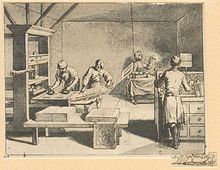
Xerography

Xerography or electrophotography is a dry photocopying technique. Its fundamental principle was invented by American physicist Chester Carlson and based on Hungarian physicist Pál Selényi's publications. Chester Carlson applied for and was awarded U.S. Patent 2,297,691 on October 6, 1942. The technique was originally called electrophotography. It was later renamed xerography—from the Greek roots ξηρός xeros, 'dry' and -γραφία -graphia, 'writing'—to emphasize that, unlike reproduction techniques then in use such as cyanotype, this process used no liquid chemicals. Xerography or electrophotography is a dry photocopying technique. Its fundamental principle was invented by American physicist Chester Carlson and based on Hungarian physicist Pál Selényi's publications. Chester Carlson applied for and was awarded U.S. Patent 2,297,691 on October 6, 1942. The technique was originally called electrophotography. It was later renamed xerography—from the Greek roots ξηρός xeros, 'dry' and -γραφία -graphia, 'writing'—to emphasize that, unlike reproduction techniques then in use such as cyanotype, this process used no liquid chemicals. Carlson's innovation combined electrostatic printing with photography, unlike the dry electrostatic printing process invented by Georg Christoph Lichtenberg in 1778. Carlson's original process was cumbersome, requiring several manual processing steps with flat plates. It was almost 18 years before a fully automated process was developed, the key breakthrough being use of a cylindrical drum coated with selenium instead of a flat plate. This resulted in the first commercial automatic copier, the Xerox 914, being released by Haloid/Xerox in 1960. Before that year, Carlson had proposed his idea to more than a dozen companies, but none were interested. Xerography is now used in most photocopying machines and in laser and LED printers. The first commercial use was hand processing of a flat photosensor (an electrostatic component that detects the presence of visible light) with a copy camera and a separate processing unit to produce offset lithographic plates. Today this technology is used in photocopy machines, laser printers, and digital presses which are slowly replacing many traditional offset presses in the printing industry for shorter runs. By using a cylinder to carry the photosensor, automatic processing was enabled. In 1960, the automatic photocopier was created and many millions have been built since. The same process is used in microform printers and computer output laser or LED printers. A metal cylinder called the drum is mounted to rotate about a horizontal axis. The drum rotates at the speed of paper output. One revolution passes the drum surface through the steps described below. The end-to-end dimension is the width of print to be produced plus a generous tolerance. The drums in the copiers originally developed by Xerox Corporation were manufactured with a surface coating of amorphous selenium (more recently ceramic or organic photoconductor or OPC), applied by vacuum deposition. Amorphous selenium will hold an electrostatic charge in darkness and will conduct away such a charge under light. In the 1970s, IBM Corporation sought to avoid Xerox's patents for selenium drums by developing organic photoconductors as an alternative to the selenium drum. In the original system, photocopiers that rely on silicon or selenium (and its alloys) are charged positively in use (hence work with negatively-charged 'toner' powder). Photoconductors using organic compounds are electrochemically charged vice versa to the preceding system in order to exploit their native properties in printing. Organic photoconductors are now preferred because they can be deposited on a flexible, oval or triangular, belt instead of a round drum, facilitating significantly smaller device build size. Laser printer photo drums are made with a doped silicon diode sandwich structure with a hydrogen-doped silicon light-chargeable layer, a boron nitride rectifying (diode-causing) layer that minimizes current leakage, and a surface layer of silicon doped with oxygen or nitrogen; silicon nitride is a scuff-resistant material. The steps of the process are described below as applied on a cylinder, as in a photocopier. Some variants are described within the text. Every step of the process has design variants. The physics of the xerographic process are discussed at length in a book. An electrostatic charge of −600 volts is uniformly distributed over the surface of the drum by a corona discharge from a corona unit (Corotron), with output limited by a control grid or screen. This effect can also be achieved with the use of a contact roller with a charge applied to it. Essentially, a corona discharge is generated by a very thinwire 1⁄4 to 1⁄2 inch (6.35 to 12.7 mm) away from the photoconductor. A negative charge is placed on the wire, which will ionize the space between the wire and conductor, so electrons will be repelled and pushed away onto the conductor. The conductor is set on top of a conducting surface, kept at ground potential.
